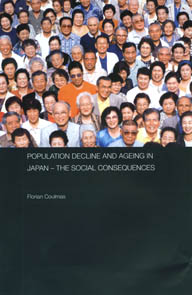
Details
2007, ISBN 9780415401258, £75.00, Routledge, London, New York, 176 p.Authors
Coulmas, Florian
Reviews
Campbell, John Creighton
Japan's Aging Population: Perspectives of "Catastrophic Demography" The Journal of Asian Studies Vol.67, No 4
pp. 1401-1406
Japan's Aging Population: Perspectives of "Catastrophic Demography" The Journal of Asian Studies Vol.67, No 4
pp. 1401-1406
Usui, Chikako
Population Decline and Ageing in Japan - The Social Consequences Journal of Japanese Studies 35:2 (2009)
pp. 464-470
Population Decline and Ageing in Japan - The Social Consequences Journal of Japanese Studies 35:2 (2009)
pp. 464-470
Campbell, Ruth
Population Decline and Ageing in Japan - The Social Consequences Pacific Affair: Volume 81, No.3 - Fall 2008
pp. 471-472
Population Decline and Ageing in Japan - The Social Consequences Pacific Affair: Volume 81, No.3 - Fall 2008
pp. 471-472
Population Decline and Ageing in Japan - The Social Consequences

This book presents a comprehensive analysis of one of the most pressing
challenges facing Japan today: population decline and ageing.
It argues that social ageing is a phenomenon that follows in the wake
of industrialization, urbanization and social modernization, bringing
about changes in values, institutions, social structures, economic
activity, technology and culture, and posing many challenges for the
countries affected. Focusing on the experience of Japan, the author
explores:
- how Japan has recognized the emerging problems relatively
early because during the past half century population ageing has been
more rapid in Japan than in any other country - how all of Japanese society is affected by social ageing,
not just certain substructures and institutions, and explains its
complex causes, describes the resulting challenges and analyses the
solutions under consideration to deal with it - the nature of Japan’s population dynamics since 1920, and
argues that Japan is rapidly moving in the direction of a ‘hyperaged
society’ in which those sixty-five or older account for twenty-five per
cent of the total population - the implications for family structures and other social
networks, gender roles and employment patterns, health care and welfare
provision, pension systems, immigration policy, consumer and voting
behaviour and the cultural reactions and ramifications of social ageing.